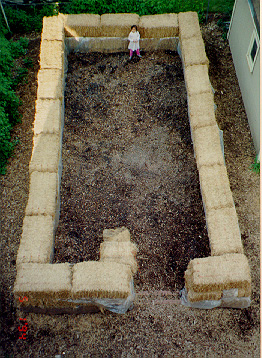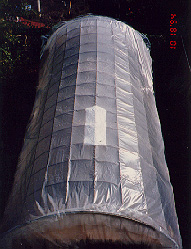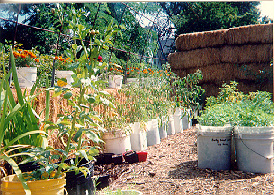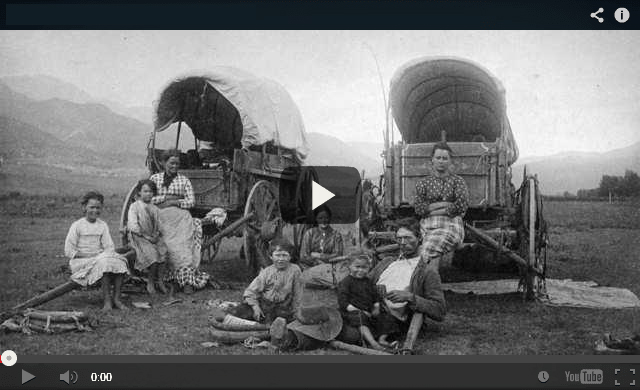Our household of 2 adults and three children obtained all our household hot water from a composting greenhouse we constructed in Portland, Oregon in 1994. It provided hot water at a temperature of 90-130 degrees (Fahrenheit) continuously until it was dismantled 18 months later. We used the space to grow several species of mushrooms and to house plants from our garden during winter.
The greenhouse design was similar to inexpensive “tube” greenhouses. Outer dimensions were 16×30 feet. The foundation walls consisted of 3 courses of rye grass straw bales pinned together with 1/2 inch steel rebar. Bale size was 2 feet x 2 feet x 4 feet, giving two-foot thick walls along the base. Therefore inner dimensions were 12 feet wide by 26 feet long. Bales were stacked like bricks, as is typical of straw bale construction. A layer of 3 mil plastic film surrounded the bottom bales, separating the straw from a layer of wood chips on which the bales rested and the compost which filled the greenhouse about three feet deep inside (except for a 5 feet by 12 feet entry at one end). The roof consisted of 6 mil ultraviolet resistant plastic film supported on 20 foot arches of rebar spaced every 2 feet along the length of the structure. These arches were held rigidly into a 2 feet x 2 feet matrix with horizontal rebar spaced every 2 feet running the length of the structure. The straw bales on the sides and end walls were also covered with the same plastic film as the roof with a door framed out of lumber at one end. A single sheet of 32 feet wide by 32 feet long plastic covered the roof.
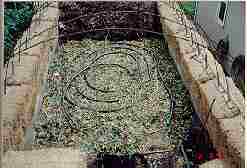 Two PVC 3/4 inch water lines ran underground from the house to the greenhouse. The cold water supply originated at the washer hookup cold line. Hot water returned from the greenhouse in an insulated line after circulating in the hot compost and entered the house plumbing at the washer hot water hookup. Therefore no modifications to the original house plumbing system were required. While the greenhouse heater was operative, the original hot water heater was turned off and its intake valve closed. Heat exchange occurred in the compost in which was embedded one hundred feet of coiled 1.5 inch internal diameter plastic hose. Compost mass totaled 3 feet deep, 12 feet wide, and 21 feet long, or approximately 28 cubic yards. It required replenishing several times during its lifetime because of continual slow decomposition.
Two PVC 3/4 inch water lines ran underground from the house to the greenhouse. The cold water supply originated at the washer hookup cold line. Hot water returned from the greenhouse in an insulated line after circulating in the hot compost and entered the house plumbing at the washer hot water hookup. Therefore no modifications to the original house plumbing system were required. While the greenhouse heater was operative, the original hot water heater was turned off and its intake valve closed. Heat exchange occurred in the compost in which was embedded one hundred feet of coiled 1.5 inch internal diameter plastic hose. Compost mass totaled 3 feet deep, 12 feet wide, and 21 feet long, or approximately 28 cubic yards. It required replenishing several times during its lifetime because of continual slow decomposition.
The total amount of hot water contained in the hose inside the compost (comprising a cylinder 100 feet long by 1.5 inch diameter) was 9.17 gallons. This (when mixed with appropriate cold water) was an adequate volume to take 3 quick showers without running out of hot water.
The compost biomass consisted of wood chips and other ground tree material run through a chipping machine. This material is delivered to our site free of charge from many tree service companies. We supplemented this primarily high-carbon matter with high-nitrogen matter from household waste such as garden debris, kitchen compost, and manures. Eventually, when the greenhouse was dismantled to reclaim our back yard as a garden area, we had enough finish compost to cover our entire yard 8 inches deep. Needless to say, we have a fabulous garden from this new soil fertility.
Our grandfathers had more knowledge than any of us today and thrived even when modern conveniences were not available. They were able to produce and store their food for long periods of time. The Lost Ways is the most comprehensive book available. All the knowledge our grandfathers had, in one place.Here’s just a glimpse of what you’ll find in the book:
Table Of Contents:
Making Your Own Beverages: Beer to Stronger Stuff
Ginger Beer: Making Soda the Old Fashioned Way
How North American Indians and Early Pioneers Made Pemmican
Wild West Guns for SHTF and a Guide to Rolling Your Own Ammo
How Our Forefathers Built Their Sawmills, Grain Mills,and Stamping Mills
How Our Ancestors Made Herbal Poultice to Heal Their Wounds
What Our Ancestors Were Foraging For? or How to Wildcraft Your Table
How North California Native Americans Built Their Semi-subterranean Roundhouses
Our Ancestors’Guide to Root Cellars
Good Old Fashioned Cooking on an Open Flame
Learning from Our Ancestors How to Preserve Water
Learning from Our Ancestors How to Take Care of Our Hygiene When There Isn’t Anything to Buy
How and Why I Prefer to Make Soap with Modern Ingredients
Temporarily Installing a Wood-Burning Stove during Emergencies
Making Traditional and Survival Bark Bread…….
Trapping in Winter for Beaver and Muskrat Just like Our Forefathers Did
How to Make a Smokehouse and Smoke Fish
Survival Lessons From The Donner Party
Get your paperback copy HERE
Books can be your best pre-collapse investment.
The Lost Ways (Learn the long forgotten secrets that helped our forefathers survive famines,wars,economic crisis and anything else life threw at them)
Survival MD (Best Post Collapse First Aid Survival Guide Ever)
Conquering the coming collapse (Financial advice and preparedness )
Liberty Generator (Build and make your own energy source)
Backyard Liberty (Easy and cheap DIY Aquaponic system to grow your organic and living food bank)
Bullet Proof Home (A Prepper’s Guide in Safeguarding a Home )
Family Self Defense (Best Self Defense Strategies For You And Your Family)
Survive Any Crisis (Best Items To Hoard For A Long Term Crisis)
Survive The End Days (Biggest Cover Up Of Our President)
Drought USA (Discover The Amazing Device That Turns Air Into Water)
SOURCE : kailashecovillage.com

